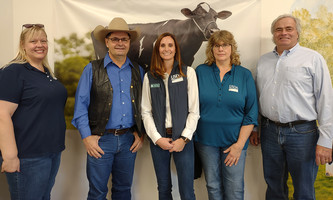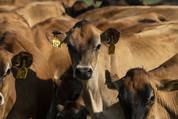
Last week, we were honored to have the Administrator of Farm Service Agency, Zach Ducheneaux, visit New York to tour some farms and hold a roundtable for producers. His visit provided us a great opportunity to showcase the tremendous diversity of agriculture in New York.
We started the day at a very productive 2-acre diversified vegetable urban farm on the East side of Buffalo. Then traveled to a state-of-the-art onion packing house in Elba, on one of the largest vegetable farms in New York, where we also introduced the Administrator to one of the more unique resources in New York, our coveted muck soil. Finally, we visited a superb dairy farm in Batavia and viewed the operation of a 72-unit, robotic rotary parlor. After the tours, Administrator Ducheneaux held a roundtable discussion with local producers representing a broad range of farm production. At the roundtable, he highlighted the priorities of this administration, including increasing equity. This means making sure we have programs and loans that help all types of producers with individualized levels of support to help each of them achieve success and profitability.
Mentioning the urban farm we visited earlier that day, the Administrator talked about the role of urban agriculture in building awareness of the food system, helping consumers better understand where food comes from. How urban farms can play an important role within urban communities, providing jobs and business opportunities as well as brining communities together through shared interests and access to fresh nutritious food.
In addition, Administrator Ducheneaux talked about plans to expand access to credit through FSA’s farm loan programs. He described how FSA loans help new farmers establish their farms and help existing farmers manage their way through difficult times. He emphasized, how this program builds strong rural economies through supporting agriculture which, along with interest earned from these loans, generates real economic return to the American taxpayers.
Finally, Administrator Ducheneaux explained how climate smart practices should benefit farmers and incentives installing these practices, as well as compensating farms that have been doing beneficial things for soil health, like cover crops and reduced tillage. In turn, producers brought up programs that and services that could be improved upon, in addition to credit, they mentioned our Noninsured Crop Disaster Assistance Program and setting a minimum acreage for wetland compliance.
It was an honor and pleasure to host Administrator Ducheneaux and show him some of the agriculture we have here in New York. It was inspiring and reassuring to hear he has the same dedication and focus to expanding FSA’s ability to help all types of farms through programs and loans as I do. I will continue to push for these expansions, like we accomplished with expanding the eligible commodities for Farm Storage Facility Loans (FSFL) seven years ago in my first stint as the New York State Executive Director. Now FSFLs can be used for fruit, vegetable and cut flower cold storage, milk and maple sap bulk tanks and siloes, freezers for meat and poultry, and much more! I hope we can improve upon more programs and loans in the future.
As the harvest season winds down and holiday season approaches, I hope you are able to enjoy time with your friends and family.
All the best,
Jim Barber
|

Agricultural producers who have not yet completed their crop acreage reports after spring planting should make an appointment with their local Farm Service Agency (FSA) before the applicable deadline.
An acreage report documents a crop grown on a farm or ranch and its intended uses. Filing an accurate and timely acreage report for all crops and land uses, including failed acreage and prevented planted acreage, can prevent the loss of benefits.
The following acreage reporting dates are applicable for New York:
- November 15, 2022 - Fall Seeded Small Grains
- January 3, 2023 - Maple Taps & Honeybees
How to File a Report
Service Center staff continue to work with agricultural producers via phone, email, and other digital tools. Because of the pandemic, some USDA Service Centers are open to limited visitors. Contact the Name County FSA office to set up an in-person or phone appointment.
To file a crop acreage report, you will need to provide:
- Crop and crop type or variety.
- Intended use of the crop.
- Number of acres of the crop.
- Map with approximate boundaries for the crop.
- Planting date(s).
- Planting pattern, when applicable.
- Producer shares.
- Irrigation practice(s).
- Acreage prevented from planting, when applicable.
- Other information as required.
Acreage Reporting Details
The following exceptions apply to acreage reporting dates:
- If the crop has not been planted by the acreage reporting date, then the acreage must be reported no later than 15 calendar days after planting is completed.
- If a producer acquires additional acreage after the acreage reporting date, then the acreage must be reported no later than 30 calendar days after purchase or acquiring the lease. Appropriate documentation must be provided to the county office.
Producers should also report crop acreage they intended to plant, but due to natural disaster, were unable to plant. Prevented planting acreage must be reported on form CCC-576, Notice of Loss, no later than 15 calendar days after the final planting date as established by FSA and USDA’s Risk Management Agency.
Noninsured Crop Disaster Assistance Program (NAP) policy holders should note that the acreage reporting date for NAP-covered crops is the earlier of the dates listed above or 15 calendar days before grazing or harvesting of the crop begins.
|

Dairy producers can now enroll for 2023 coverage through the Dairy Margin Coverage (DMC) Program, an important safety net program from the U.S. Department of Agriculture (USDA) that helps producers manage changes in milk and feed prices. Last year, USDA’s Farm Service Agency (FSA) took steps to improve coverage, especially for small- and mid-sized dairies, including offering a new Supplemental DMC program and updating its feed cost formula to better address retroactive, current and future feed costs. These changes continue to support producers through this year’s signup, which ends Dec. 9, 2022.
DMC is a voluntary risk management program that offers protection to dairy producers when the difference between the all-milk price and the average feed price (the margin) falls below a certain dollar amount selected by the producer.
So far in 2022, DMC payments to more than 17,000 dairy operations have triggered for August for more than $47.9 million. According to DMC margin projections, an indemnity payment is projected for September as well. At $0.15 per hundredweight for $9.50 coverage, risk coverage through DMC is a relatively inexpensive investment.
DMC offers different levels of coverage, even an option that is free to producers, aside from a $100 administrative fee. Limited resource, beginning, socially disadvantaged or a military veteran farmers or ranchers are exempt from paying the administrative fee, if requested. To determine the appropriate level of DMC coverage for a specific dairy operation, producers can use the online dairy decision tool.
Supplemental DMC
Last year, USDA introduced Supplemental DMC, which provided $42.8 million in payments to better help small- and mid-sized dairy operations that had increased production over the years but were not able to enroll the additional production. Supplemental DMC is also available for 2023.
Supplemental DMC coverage is applicable to calendar years 2021, 2022 and 2023. Eligible dairy operations with less than 5 million pounds of established production history may enroll supplemental pounds.
For producers who enrolled in Supplemental DMC in 2022, the supplemental coverage will automatically be added to the 2023 DMC contract that previously established a supplemental production history.
Producers who did not enroll in Supplemental DMC in 2022 can do so now. Producers should complete their Supplemental DMC enrollment before enrolling in 2023 DMC. To enroll, producers will need to provide their 2019 actual milk marketings, which FSA uses to determine established production history.
DMC Payments
Additionally, FSA will continue to calculate DMC payments using updated feed and premium hay costs, making the program more reflective of actual dairy producer expenses. These updated feed calculations use 100% premium alfalfa hay rather than 50%. The benefits of these feed cost adjustments were realized in the recent August 2022 margin payment as current high feed and premium hay costs were considered in payment calculations.
More Information
In addition to DMC, USDA offers other risk management tools for dairy producers, including the Dairy Revenue Protection (DRP) plan that protects against a decline in milk revenue (yield and price) and the Livestock Gross Margin (LGM) plan, which provides protection against the loss of the market value of livestock minus the feed costs. Both DRP and LGM livestock insurance policies are offered through the Risk Management Agency. Producers should contact their local crop insurance agent for more information.
For more information on DMC, visit the DMC webpage or contact your local USDA Service Center.
|
The U.S. Department of Agriculture (USDA) began mailing ballots this week for the Farm Service Agency (FSA) county and urban county committee elections to all eligible agricultural producers and private landowners across the country.
Elections are occurring in certain Local Administrative Areas (LAA) for these committee members who make important decisions about how federal farm programs are administered locally. Producers and landowners must return ballots to their local FSA county office or have their ballots be postmarked by Dec. 5, 2022, in order for those ballots to be counted.
Producers must participate or cooperate in an FSA program to be eligible to vote in the county committee election. A cooperating producer is someone who has provided information about their farming or ranching operation but may not have applied or received FSA program benefits. Additionally, producers who are not of legal voting age but supervise and conduct farming operations for an entire farm are eligible to vote in these elections.
Each committee has from three to 11 elected members who serve three-year terms, and at least one seat representing an LAA is up for election each year. Ballots must in the mail or delivered in person by close of business Dec. 5, 2022, to be counted. Newly elected committee members will take office Jan. 1, 2023.
Producers can find out if their LAA is up for election and if they are eligible to vote by contacting their local FSA county office. Eligible voters who do not receive a ballot in the mail can request one from their local FSA county office. Visit farmers.gov/service-locator to find your local USDA Service Center and fsa.usda.gov/elections for more information.
Urban and Suburban County Committees
The 2018 Farm Bill directed USDA to establish county committees specifically focused on urban agriculture.
Urban committee members are nominated and elected to serve by local urban producers in the same jurisdiction. Urban county committee members will provide outreach to ensure urban producers understand USDA programs and serve as the voice of other urban producers and assist in program implementation that support the needs of the growing urban community.
Urban and suburban county committees in the following cities will hold elections this year: Phoenix, Atlanta, New Orleans, Minneapolis-St. Paul, St. Louis, Albuquerque, Cleveland, Portland, Philadelphia, Dallas, and Richmond. These elections will serve local urban producers in the same jurisdiction. A fact sheet on the urban county committee election and a list of eligible cities can be found at fsa.usda.gov/elections.
Over the summer, USDA announced six new urban county committees in Chicago, Detroit, Grand Rapids, Los Angeles, New York City, and Oakland. The nomination period for these locations began Oct. 21 and will end on Dec. 2, 2022. Elections will be held from Jan. 3 through Jan. 31, 2023. Learn more about the New York City Urban County Committee at https://www.fsa.usda.gov/state-offices/New-York/programs/urban-ag.
More Information
USDA touches the lives of all Americans each day in so many positive ways. In the Biden-Harris administration, USDA is transforming America’s food system with a greater focus on more resilient local and regional food production, fairer markets for all producers, ensuring access to safe, healthy and nutritious food in all communities, building new markets and streams of income for farmers and producers using climate smart food and forestry practices, making historic investments in infrastructure and clean energy capabilities in rural America, and committing to equity across the Department by removing systemic barriers and building a workforce more representative of America. To learn more, visit usda.gov.

America’s farmers and ranchers will soon have the opportunity to be represented in the nation’s only comprehensive and impartial agriculture data for every state, county and territory. The U.S. Department of Agriculture (USDA) will mail the 2022 Census of Agriculture to millions of agriculture producers across the 50 states and Puerto Rico this fall.
The 2022 Census of Agriculture will be mailed in phases, starting with an invitation to respond online in November followed by paper questionnaires in December. Farm operations of all sizes, urban and rural, which produced and sold, or normally would have sold, $1,000 or more of agricultural product in 2022 are included in the ag census.
Collected in service to American agriculture since 1840 and now conducted every five years by USDA’s National Agricultural Statistics Service (NASS), the Census of Agriculture tells the story and shows the value of U.S. agriculture. It highlights land use and ownership, producer characteristics, production practices, income and expenditures, among other topics. Between ag census years, NASS considers revisions to the questionnaire to document changes and emerging trends in the industry. Changes to the 2022 questionnaire include new questions about the use of precision agriculture, hemp production, hair sheep, and updates to internet access questions.
To learn more about the Census of Agriculture, visit nass.usda.gov/AgCensus or call 800-727-9540. On the website, producers and other data users can access frequently asked questions, past ag census data, partner tools to help spread the word about the upcoming ag census, special study information, and more. For highlights of these and the latest information on the upcoming Census of Agriculture, follow USDA NASS on twitter @usda_nass.
|

The U.S. Department of Agriculture (USDA) launched a new online tool to help farmers and ranchers better navigate the farm loan application process. This uniform application process will help to ensure all farm loan applicants receive equal support and have a consistent customer experience with USDA’s Farm Service Agency (FSA) regardless of their individual circumstances.
USDA experiences a high rate of incomplete or withdrawn applications, particularly among underserved customers, due in part to a challenging and lengthy paper-based application process. The Loan Assistance Tool is available 24/7 and gives customers an online step-by-step guide that supplements the support they receive when working in person with a USDA employee, providing materials that may help an applicant prepare their loan application in one tool.
Farmers can access the Loan Assistance Tool by visiting farmers.gov/farm-loan-assistance-tool and clicking the ‘Get Started’ button. From here they can follow the prompts to complete the Eligibility Self-Assessment and start the farm loan journey. The tool is built to run on any modern browser like Chrome, Edge, Firefox, or the Safari browser, and is fully functional on mobile devices. It does not work in Internet Explorer.
The Loan Assistance Tool is the first of multiple farm loan process improvements that will be available to USDA customers on farmers.gov in the future. Other improvements and tools that are anticipated to launch in 2023 include:
- A streamlined and simplified direct loan application, reduced from 29 pages to 13 pages.
- An interactive online direct loan application that gives customers a paperless and electronic signature option, along with the ability to attach supporting documents such as tax returns.
- An online direct loan repayment feature that relieves borrowers from the necessity of calling, mailing, or visiting a local Service Center to pay a loan installment.
Background
USDA provides access to credit to approximately 115,000 producers who cannot obtain sufficient commercial credit through direct and guaranteed farm loans. With the funds and direction Congress provided in Section 22006 of the Inflation Reduction Act, USDA is taking action to immediately provide relief to qualifying distressed borrowers whose operations are at financial risk while working on making transformational changes to loan servicing so that borrowers are provided the flexibility and opportunities needed to address the inherent risks and unpredictability associated with agricultural operations.
|
Agricultural producers can now change election and enroll in the Agriculture Risk Coverage (ARC) and Price Loss Coverage programs for the 2023 crop year, two key safety net programs offered by the U.S. Department of Agriculture (USDA). Signup began Monday, and producers have until March 15, 2023, to enroll in these two programs. Additionally, USDA’s Farm Service Agency (FSA) has started issuing payments totaling more than $255 million to producers with 2021 crops that have triggered payments through ARC or PLC.
2023 Elections and Enrollment
Producers can elect coverage and enroll in ARC-County (ARC-CO) or PLC, which provide crop-by-crop protection, or ARC-Individual (ARC-IC), which protects the entire farm. Although election changes for 2023 are optional, producers must enroll through a signed contract each year. Also, if a producer has a multi-year contract on the farm and makes an election change for 2023, they must sign a new contract.
If producers do not submit their election by the March 15, 2023 deadline, their election remains the same as their 2022 election for crops on the farm. Farm owners cannot enroll in either program unless they have a share interest in the farm.
Covered commodities include barley, canola, large and small chickpeas, corn, crambe, flaxseed, grain sorghum, lentils, mustard seed, oats, peanuts, dry peas, rapeseed, long grain rice, medium and short grain rice, safflower seed, seed cotton, sesame, soybeans, sunflower seed and wheat.
Web-Based Decision Tools
In partnership with USDA, the University of Illinois and Texas A&M University offer web-based decision tools to assist producers in making informed, educated decisions using crop data specific to their respective farming operations. Tools include:
-
Gardner-farmdoc Payment Calculator, a tool available through the University of Illinois allows producers to estimate payments for farms and counties for ARC-CO and PLC.
-
ARC and PLC Decision Tool, a tool available through Texas A&M that allows producers to obtain basic information regarding the decision and factors that should be taken into consideration such as future commodity prices and historic yields to estimate payments for 2022.
2021 Payments and Contracts
ARC and PLC payments for a given crop year are paid out the following fall to allow actual county yields and the Market Year Average prices to be finalized. This month, FSA processed payments to producers enrolled in 2021 ARC-CO, ARC-IC and PLC for covered commodities that triggered for the crop year.
For ARC-CO, producers can view the 2021 ARC-CO Benchmark Yields and Revenues online database, for payment rates applicable to their county and each covered commodity. For PLC, payments have triggered for rapeseed and peanuts.
For ARC-IC, producers should contact their local FSA office for additional information pertaining to 2021 payment information, which relies on producer-specific yields for the crop and farm to determine benchmark yields and actual year yields when calculating revenues.
By the Numbers
In 2021, producers signed nearly 1.8 million ARC or PLC contracts, and 251 million out of 273 million base acres were enrolled in the programs. For the 2022 crop year signed contracts surpassed 1.8 million, to be paid in the fall of 2023, if a payment triggers.
Since ARC and PLC were first authorized by the 2014 Farm Bill and reauthorized by the 2018 Farm Bill, these safety-net programs have paid out more than $34.9 billion to producers of covered commodities.
Crop Insurance Considerations
ARC and PLC are part of a broader safety net provided by USDA, which also includes crop insurance and marketing assistance loans.
Producers are reminded that ARC and PLC elections and enrollments can impact eligibility for some crop insurance products.
Producers on farms with a PLC election have the option of purchasing Supplemental Coverage Option (SCO) through their Approved Insurance Provider; however, producers on farms where ARC is the election are ineligible for SCO on their planted acres for that crop on that farm.
Unlike SCO, the Enhanced Coverage Option (ECO) is unaffected by an ARC election. Producers may add ECO regardless of the farm program election.
More Information
For more information on ARC and PLC, visit the ARC and PLC webpage or contact your local USDA Service Center.

The USDA Farm Service Agency’s (FSA) Direct Farm Ownership loans can help farmers and ranchers become owner-operators of family farms, improve and expand current operations, increase agricultural productivity, and assist with land tenure to save farmland for future generations.
There are three types of Direct Farm Ownership Loans: regular, down payment and joint financing. FSA also offers a Direct Farm Ownership Microloan option for smaller financial needs up to $50,000.
Joint financing allows FSA to provide more farmers and ranchers with access to capital. FSA lends up to 50 percent of the total amount financed. A commercial lender, a State program or the seller of the property being purchased, provides the balance of loan funds, with or without an FSA guarantee. The maximum loan amount for a joint financing loan is $600,000, and the repayment period for the loan is up to 40 years.
The operation must be an eligible farm enterprise. Farm Ownership loan funds cannot be used to finance nonfarm enterprises and all applicants must be able to meet general eligibility requirements. Loan applicants are also required to have participated in the business operations of a farm or ranch for at least three years out of the 10 years prior to the date the application is submitted. The applicant must show documentation that their participation in the business operation of the farm or ranch was not solely as a laborer.
For more information on FSA farm loan programs, contact your local USDA Service Center or visit fsa.usda.gov.
|

At USDA, we are committed to helping farmers complete loan applications, environmental reviews, and other paperwork free of charge. One-on-one support is available at more than 2,300 USDA Service Centers nationwide. USDA’s Farm Service Agency and Natural Resources Conservation Service staff are usually co-located at these Service Centers and can help guide farmers to the best USDA assistance based on their unique goals, whether it is loans, conservation programs, or insurance.
Service Center staff can guide farmers through the process of preparing and submitting required paperwork on their own, with no need to hire a paid preparer. Language translation service is available in all USDA Service Centers, so one-on-one assistance with a Service Center employee can be translated in real time for farmers requiring it. And while some program and loan applications do have an administrative fee for filing, there is never a charge for preparation services provided by USDA staff.
Farmers who work with the USDA Service Center can:
- Establish their farm by registering for a farm number, which is required for USDA programs and assistance.
- Learn how to meet conservation compliance provisions.
- Verify eligibility for USDA programs.
- Discuss their business and conservation goals.
- Create a conservation plan.
- Fill out and file loan and program applications.
We are committed to delivering USDA programs and services to America’s farmers and ranchers while taking safety measures in response to COVID-19. We encourage you to check the status of your local USDA Service Center and make an appointment to discuss your business needs.
|

The Farm Service Agency (FSA) administers two programs that have specific safety net benefits for producers of honeybees and honey. The Noninsured Crop Disaster Assistance Program (NAP) and the Emergency Assistance for Livestock, Honeybees and Farm-Raised Fish Program (ELAP) assist producers when disasters impact honey production or damage or destroy colonies, hives or honeybee feed.
NAP is designed to reduce financial losses when natural disasters result in lower yields or crop losses, including honey. NAP coverage is equivalent to catastrophic insurance, meaning it covers up to 50 percent of a producer’s normal yield (must have at least a 50 percent loss) at 55 percent of the average market price. The 2018 Farm Bill reinstates higher levels of coverage, from 50 to 65 percent of expected production in 5 percent increments, at 100 percent of the average market price. Producers of organics and crops marketed directly to consumers also may exercise the “buy-up” option to obtain NAP coverage of 100 percent of the average market price at the coverage levels of between 50 and 65 percent of expected production.
The NAP service fee is the lesser of $325 per crop or $825 per producer per administrative county, not to exceed a total of $1,950 for a producer with farming interests in multiple counties.
You must apply for NAP coverage by December 31 prior to the year for which you’re seeking coverage.
ELAP covers colony losses, honeybee hive losses (the physical structure) and honeybee feed losses in instances where the colony, hive or feed has been destroyed by a natural disaster or, in the case of colony losses, because of Colony Collapse Disorder. Colony losses must be in excess of normal mortality.
Both the NAP and ELAP programs require you to report the number of colonies you have in production to FSA by Jan. 3, 2023. You must notify FSA within 30 calendar days of changes in the total number of colonies or when honeybees are moved to another county.
For both programs, you must notify FSA within 15 calendar days of when a loss occurs or from when the loss is apparent.
To learn more about programs for honey and honeybee producers, contact your local USDA Service Center or visit fsa.usda.gov.
|
Are you a farmer, rancher or forest manager? Please share your vital feedback with USDA by taking a nationwide survey at farmers.gov/survey! The survey is completely anonymous, will take about 10 minutes to complete, is available in multiple languages, and will be open until March 31, 2023. The survey focuses on gathering feedback about the Farm Service Agency, Natural Resources Conservation Service and Risk Management Agency.
All farmers, ranchers and forest managers are encouraged to take the survey. USDA would especially like to hear from prospective customers: those who don’t know about USDA or have yet to work with USDA, and those who were unable to participate in the past. The survey will help USDA enhance support, improve programs and services, increase access, and advance equity for new and existing customers.
|